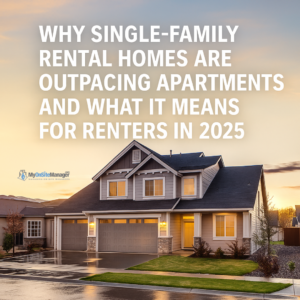The U.S. rental market is undergoing a significant shift that’s reshaping how Americans live, move, and budget for housing. A new report from Zillow, highlighted by HousingWire, shows a trend that has become impossible to ignore: single-family rental homes are becoming more expensive at a much faster rate than apartments and the price gap between the two has never been wider.
For renters looking for space and privacy, the numbers may feel discouraging. For property managers and investors, these patterns reveal both opportunity and changing expectations. For the industry as a whole, they signal a new chapter in the evolving post-pandemic housing landscape.
The Numbers Tell a Clear Story: Single-Family Homes Are Surging
Zillow’s December 2024 data reveals a striking divide:
Typical Single-Family Rent (Top 50 Metros)
-
$2,174/month
-
Up 4.4% year-over-year
-
Up 40.6% since early 2020
Typical Apartment Rent
-
$1,812/month
-
Up 2.4% year-over-year
-
Up 26.2% since early 2020
That leaves a rent gap of roughly 20% the largest margin Zillow has ever recorded.
This isn’t a momentary spike. It’s a structural divergence driven by long-term forces affecting where and how people want to live.
Why Are Single-Family Rentals Becoming So Expensive?
Several factors are converging to push these rents upward faster than apartments.
1. Homebuyers Are Sitting on the Sidelines
High mortgage rates, elevated home prices, and steep down-payment requirements have pushed many would-be homebuyers into the rental market particularly young families and millennials.
When buying becomes unaffordable, demand for single-family rentals rises.
And demand is rising faster than supply.
2. Single-Family Supply Is Not Keeping Pace
While apartment construction is booming, single-family rentals are much harder to scale.
-
Builders are focused heavily on multifamily units.
-
“Build-to-rent” communities exist, but not in volumes that can meet national demand.
-
Many owners are holding onto their homes longer due to high interest rates, limiting inventory for renters.
So even as metros add thousands of apartments, detached rental homes remain limited and therefore more expensive.
3. Renters Want More Space Than Ever Before
The pandemic permanently reshaped preferences:
-
More rooms for remote work
-
Private outdoor areas
-
Less noise
-
More storage
-
A neighborhood feel rather than a high-rise lifestyle
Even now, years after lockdowns ended, the desire for privacy and space continues to drive renters toward single-family homes.
4. Concessions Are Rising But Mostly for Apartments
A surprising twist from the Zillow data:
41% of all rental listings in December 2024 offered concessions up from 32.6% the previous year.
These promos include:
-
1–2 months free rent
-
Free parking
-
Reduced deposits
-
Flexible lease terms
But concessions are mostly concentrated in the apartment sector, where supply is much more abundant. Single-family homes, by contrast, rarely need them.
Where the Gap Is Widest
While the national gap is around 20%, some metros are experiencing far more dramatic differences.
Top Markets With the Biggest Rent Gaps
-
Salt Lake City: Single-family rents are 59% higher than apartments
-
Denver: 58% gap
-
Los Angeles: 55% gap
-
Portland: 54% gap
-
Providence: 54% gap
These metros share similar traits:
-
Strong population inflows
-
Young professional families
-
Limited buildable land
-
Slow single-family construction
-
High homeownership barriers
In all 50 metros Zillow tracked, single-family rents increased, a strong signal of sustained demand.
How This Affects Renters in 2025
1. Renting a house is becoming a luxury.
As single-family rents climb, these homes are increasingly accessible only to higher-earning households or those who prioritize space over affordability.
2. Apartments may become the “budget-friendly” alternative.
With new supply flooding the market and concessions rising, renters may find better pricing power in multifamily communities.
3. Budget pressures are real.
The typical renter now spends 29.3% of income on rent, compared to 26.9% before the pandemic a meaningful jump.
What It Means for Property Managers & Investors
1. Single-family portfolios hold growing value
Rising rents make these assets extremely attractive but only if managed efficiently.
2. Operational challenges increase
Detached homes require:
-
More maintenance
-
More inspections
-
More yard/exterior care
-
Higher turn-costs
Managers need clear systems, workflows, and vendor coordination.
3. Marketing strategies must change
Single-family homes command a premium, so value-driven messaging is key:
-
Privacy
-
Space
-
Family-friendly layout
-
Work-from-home suitability
-
Neighborhood lifestyle
4. Apartment managers must stay competitive
Concessions, amenities, and service quality will play a larger role in standing out in an oversupplied market.
Looking Ahead to 2025 and Beyond
The report makes one thing clear:
The divergence between single-family rentals and apartments isn’t slowing.
-
Homeownership remains difficult for many
-
Builders are focused on multifamily supply
-
Demand for space continues
-
Renters are prioritizing lifestyle quality
As long as these forces hold, single-family rents may continue to grow at a faster pace and the gap could widen even further.

